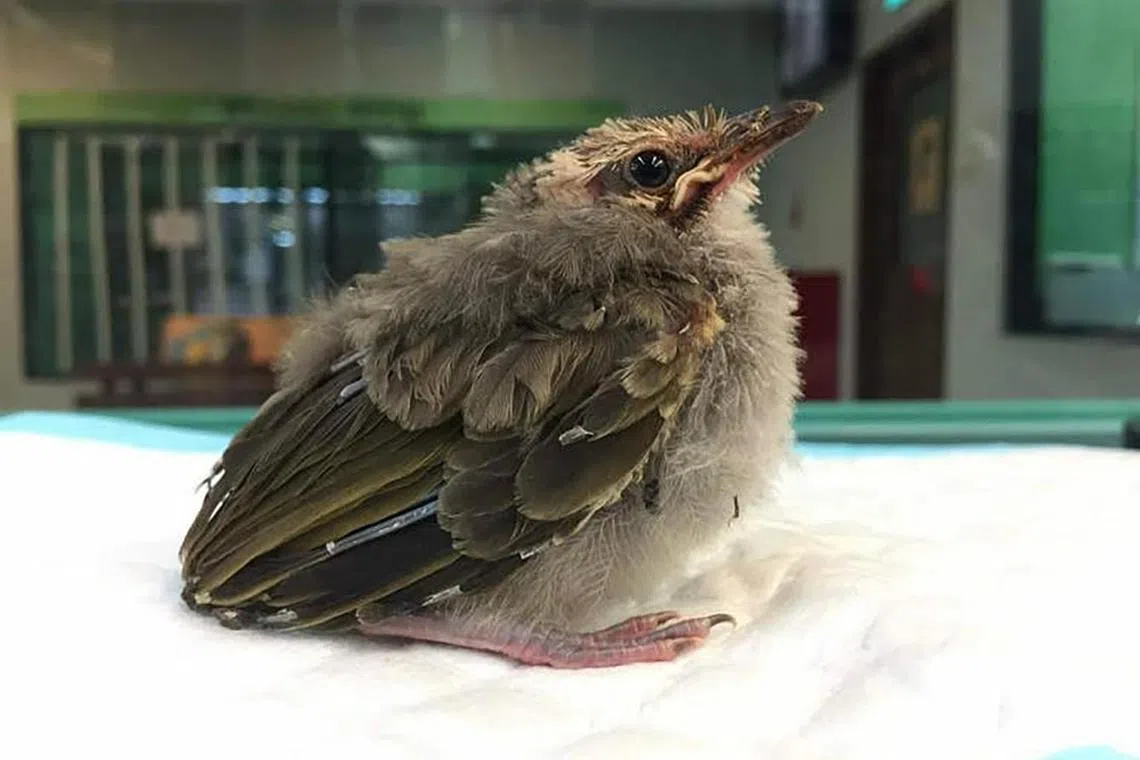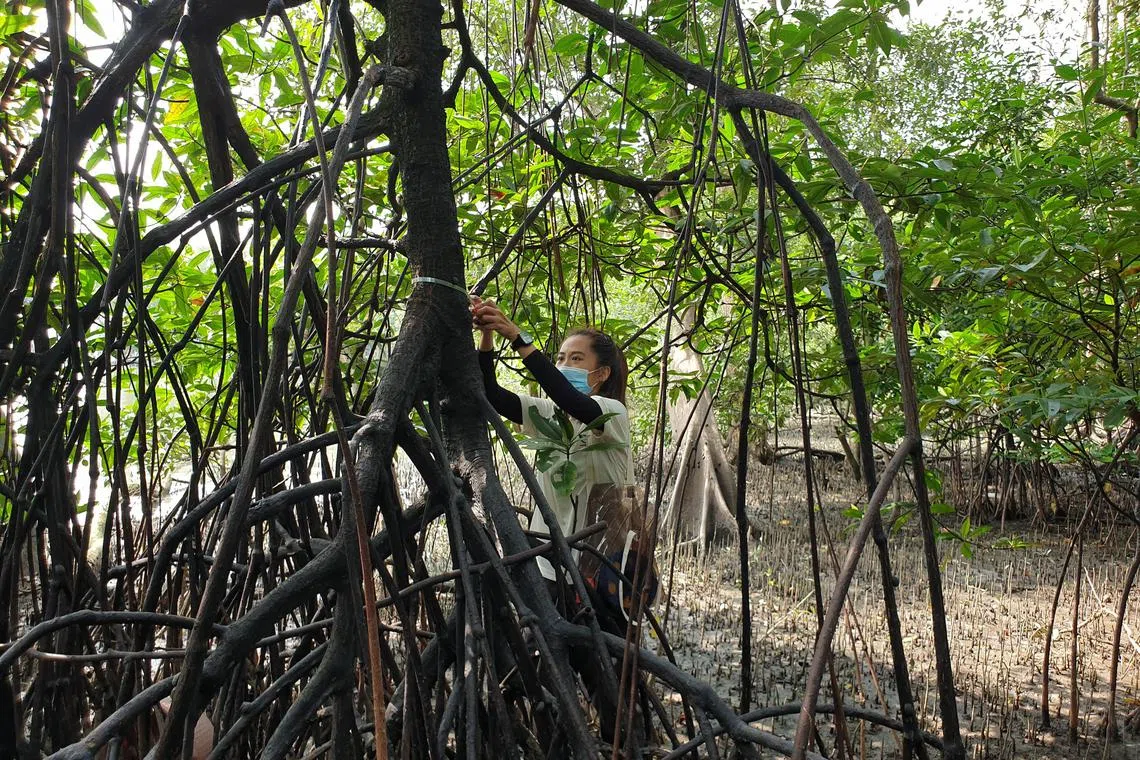National action plan to keep endangered straw-headed bulbuls singing in the wild
Sign up now: Get ST's newsletters delivered to your inbox

The straw-headed bulbul is one of the most trapped species in the Southeast Asian bird trade.
PHOTO: FRANCIS YAP
Follow topic:
SINGAPORE – There are fewer than 1,700 mature straw-headed bulbuls in the wild worldwide.
A third of this critically endangered bird species live in Singapore, making the island the sole global stronghold for the popular songbird, which is also found in other parts of South-east Asia, including Indonesia, Thailand and Myanmar.
Its rich, melodious and bubbly song makes it popular in the massive trade of caged songbirds in South-east Asia, resulting in the dwindling of its numbers.
To ensure its survival here, a working group has set up a National Species Action Plan to guide conservation efforts for the local bulbul population over the next five years. The team is led by the National Parks Board (NParks) and Nature Society (Singapore), or NSS, and members include the National University of Singapore, Mandai Wildlife Group, Mandai Nature and BirdLife International.
The five-year plan includes population monitoring, and conducting both research and outreach based on the latest scientific evidence.
“While the biggest issue overseas lies in the trapping of the birds for the cage bird trade, our own set of challenges here include trying to improve connectivity between the populations on Pulau Ubin and the mainland,” said senior manager of biodiversity at NParks Low Bing Wen.
The straw-headed bulbul’s three bastions in Singapore are Ubin-Khatib, Kranji-Mandai, and the central forest comprising Bukit Timah and the central catchment nature reserves.
One of the reasons the bird is doing comparatively well in Singapore is that it is no longer trapped here for the songbird trade, unlike in other countries in the region, such as Indonesia. Habitat loss is another key reason impacting the species’ numbers.
“In the past, keeping songbirds was popular in Singapore. Today, it is both declining in popularity and there is an increasing awareness among the local population that birds should be in the wild and singing in our parks and gardens. You can still hear or see the straw-headed bulbul regularly in our green spaces,” Mr Low said.
“In countries (in the region), you might see the odd individual or pair when you venture really far off the beaten path.”
Veteran birdwatcher and an adviser to the NSS bird group Alfred Chia added: “In places like Thailand, Myanmar, (the species) is almost extirpated, while in parts of Indonesia, like Java and Sumatra, it is almost extinct, except for the remote parts of Kalimantan.”
Extirpation of a species means it no longer found in a particular area, but not necessarily extinct.
To protect the world’s last stronghold of the straw-headed bulbul, the National Species Action Plan spells out what is needed in Singapore over a five-year period to monitor and conduct both research and outreach based on the latest scientific evidence.
NSS president Yeo Seng Beng wrote in the foreword of the plan that in contrast to the increasing habitat loss in South-east Asia, “Singapore’s conservation efforts and effective enforcement actions, coupled with the straw-headed bulbul’s tolerance for secondary forest and forest-edge habitats, have ensured its continued survival and well-being”.
One of the four key action areas is monitoring, to identify the preferred habitat of the straw-headed bulbul. Data collected by researchers is used to model its natural surroundings with vegetation structure such as canopy cover and density.
Another entails assessing the levels of inbreeding and genetic diversity of the wild population and those bred for conservation, through the genetic sequencing of wild birds and those from captive zoological collections and museum specimens.

One of three straw-headed bulbul chicks born in Jurong Bird Park in 2018. The park was the first in over a decade to breed these critically endangered species under human care.
PHOTO: MANDAI WILDLIFE GROUP
“Captive breeding creates an insurance population in case anything happens to the bird, either in Singapore or elsewhere in the region,” Mr Low said.
“Unfortunately, straw-headed bulbuls are really hard to breed in captivity. The Mandai Wildlife Group is one of the few places in the world that have successfully bred the birds in captivity. Even then, it only successfully raised nine new chicks.”
Mr Chia said wild birds will be fitted with rings on their legs, to enable the tracking of their movement and growth. Genetic monitoring will be done using material such as feathers and excrement.
On Facebook, National Development Minister Desmond Lee said the National Species Action Plan “builds upon previous efforts to up-list the straw-headed bulbul in the Convention on International Trade in Endangered Species of Wild Fauna and Flora (Cites) and community engagement sessions on actions to better protect this species”.

A priority of the National Species Action Plan is identifying the preferred habitat of the straw-headed bulbul.
PHOTO: NPARKS
The straw-headed bulbul was previously on the Cites Appendix II list since 1997, which meant its trade was regulated to avoid threatening the species’ survival.
But it was recently up-listed to the Cites Appendix I list, which meant the species faces a high risk of extinction, prohibiting its trade for commercial purposes.
Singapore, Malaysia and the United States proposed this up-listing at the COP27 climate conference in 2022, and it came into effect on Nov 25, 2023.
Singapore has been a party to Cites since November 1986.
The international agreement ensures wildlife species are not threatened to extinction by trade.

Rings are fitted on the legs of wild straw-headed bulbuls to track their movement and growth.
PHOTO: NPARKS
The straw-headed bulbul is a protected species in Singapore under the Wildlife Act, which prohibits its killing, trapping or offering of sale or import or export.
“One of the priorities (of the action plan) will be carrying out regular monitoring of local bird shops, and to deter poaching of the bulbul from the wild,” Mr Low said.
Another key prong will be raising awareness among the public of the straw-headed bulbul, to foster greater appreciation of the species and involvement in the conservation of the species, he added.


